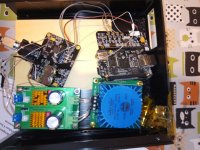Went just now to www.pulsarclock.com and saw something about 35% discount on orders between 25-27 November 2016.
I'll bite..
LH/S
I'll bite..
LH/S
Season's Greetings
Season's Greetings and Happy New Year from the Pulsar Team
An externally hosted image should be here but it was not working when we last tested it.
Season's Greetings and Happy New Year from the Pulsar Team
Dear Pulsar team,
Any application for your clock in these 2 circuits?:
The ο1 precision master clock
The γ24 high performance DAC core
Thanks! They both use the Crystek CCHD-957 with the ADM7150 (3.3V) regulator.
Best,
Anand.
Any application for your clock in these 2 circuits?:
The ο1 precision master clock
The γ24 high performance DAC core
Thanks! They both use the Crystek CCHD-957 with the ADM7150 (3.3V) regulator.
Best,
Anand.
Dear Pulsar team,
Any application for your clock in these 2 circuits?:
The ο1 precision master clock
...
There's no way to install two Pulsar Clock on the Omicron precision Master Clock.
The problem is electrical: the Pulsar Clock doesn't have a three-state output (i.e. an enable/disable capability on pin1) so it is impossible to connect two Pulsar Clock output lines the way it is implemented on Omicron 1.
Dear Pulsar team,
Any application for your clock in these 2 circuits?:
...
The γ24 high performance DAC core
...
The Gamma24 board appears to be adequate to support the Pulsar Clock.
To install the Pulsar Clock you have at least two choices:
OPTION A:
- remove the SMD clock on the Gamma24 board and build a sort of pilework to support a small board with a DIL14 socket for Pulsar Clock.
- have great care to verify the Pulsar Clock Vcc and GND connections before to power up! An inversion of the polarity burns the Pulsar Clock and it can't be repaired.
Connect Pin 7 on Pulsar Clock to Pad 2 on the Board (GND)
Connect Pin 8 on Pulsar Clock to Pad 3 on the Board (Out)
Connect Pin 14 on Pulsar Clock to Pad 4 on the Board (Vcc)
Do not connect electrically the Pin 1 of Pulsar Clock, you can use it as a mechanical fastening
Pros:
- minimum Jitter introduced by the modding, most likely insignificant.
- return current from the clock goes through the path forseen by the board designers with minimum EMI impact.
- standard 1/10" (2.54mm) parts could be used for the modding.
Cons:
- medium complexity modding, requires some expertise to remove the SMD clock that most likely won't be reusable with its maximum performance unless removed with adequate rework tools.
- a minimum of soldering experience is required to solder the pilework to the board not damaging the nearby components and the board itself
OPTION B:
- leave the SMD clock in place
- install the Pulsar Clock on a board aside but located as near as possible to the Gamma24 board, preferably using the provided Pulsar Clock socket.
- connect the three Pulsar Clock pins Vcc, GND and Out to the three points shown in the following picture. The ADM7150 should have no problem to provide power to the two clocks. We suggest to connect Vcc upstream L1 in order to have a minimum separation between the two clock power supply.
- do not solder the output wire to the Pin2 on J1, use instead a single socket connector from a 1/10" (2.54mm) row in case you want to restore the original clock.
Pros:
- easy modding, minimum expertise is required
- SMD clock remains in place and the original configuration can be restored if desired
Cons:
- some Jitter could be introduced on the output connection due to the usage of a wire. If a coaxial cable is used be sure it is an high frequency cable and DO NOT connect the shield to ground to both sides otherwise you create ground loops introducing Jitter, if you want to use a coax connect the shield to ground only at Pulsar Clock side.
- Power Supply return current have an optimum path on pin 25 of the Gamma24 board but it is not the path forseen by the board designers so some jitter could be induced on the Pulsar Clock output.
- both clocks share the same power supply running at the same time at a very very near frequency with possible interference and unpredictable Jitter effects. Often two clocks run in many systems with a unique power supply and this appears not to be a problem but is better to take it into account.
- please, note that these cons are general warnings given to obtain an optimum result but also the option B can give very satisfactory results.
An externally hosted image should be here but it was not working when we last tested it.
There's no way to install two Pulsar Clock on the Omicron precision Master Clock.
The problem is electrical: the Pulsar Clock doesn't have a three-state output (i.e. an enable/disable capability on pin1) so it is impossible to connect two Pulsar Clock output lines the way it is implemented on Omicron 1.
Pulsar,
I discussed this at the AMB forum and the designer of the Omicron 1 board replied with this:
On most standard CMOS oscillators there is an enable/disable pin (usually pin 1). This applies to the Crystek CCHD-957. It can be left floating (i.e., not connected), and an internal pull-up resistor will enable the oscillator. When the oscillator is disabled by feeding logic "low" to the enable/disable pin, the oscillator output becomes disconnected from the rest of the circuit so as not to "fight" another oscillator that is enabled.
On the γ24, this pin is not used. Thus the oscillator is always enabled.
On the ο1, the pin is used to select between the two oscillators in dual-frequency configuration (enable one but disable the other, or vice versa) via the SEL input. But in single-frequency configuration, this pin is unused and X1 is always enabled.
So it should be possible to use a pulsar clock on the ο1 when configured for single frequency only
So it should be possible to use it with the Omicron 1. Please discuss.
Thanks,
Anand.
The reply of the Omicron 1 board designer is absolutely correct.
I didn't see any reason to install a single clock on the o1 so my answer was referred to the dual clock configuration.
If you need to run only one clock the Omicron 1 works fine with a Pulsar Clock and you can place it both in the X1 or the X2 position as it appears more convenient, you just need some fine modding to fit the different pin patterns.
I didn't see any reason to install a single clock on the o1 so my answer was referred to the dual clock configuration.
If you need to run only one clock the Omicron 1 works fine with a Pulsar Clock and you can place it both in the X1 or the X2 position as it appears more convenient, you just need some fine modding to fit the different pin patterns.
Pulsar Clock is one of best clock. Pulsar Clock is the best clock if
the budget is under 900 euro dollar.
It can improve significantly my system to higher level. My system is Burmester 961, Burmester 032, NorthStar Excelsio and digital music file player including NAS, beaglebone black, ACKO new S03 (isolator and re-clocker). The quality of the network cable between NorthStar Excelsio and ACKO S03 is very important. I use Oyaide CAT7 IS-707 network cable and LINKWAY toolless RJ45 is similar with BIGtec RJ45. LINKWAY is Chinese company. LINKWAY toolless RJ45 can buy from https://www.aliexpress.com/store/pr...32766739328.html?spm=2114.12010608.0.0.L7QyfH
the budget is under 900 euro dollar.
It can improve significantly my system to higher level. My system is Burmester 961, Burmester 032, NorthStar Excelsio and digital music file player including NAS, beaglebone black, ACKO new S03 (isolator and re-clocker). The quality of the network cable between NorthStar Excelsio and ACKO S03 is very important. I use Oyaide CAT7 IS-707 network cable and LINKWAY toolless RJ45 is similar with BIGtec RJ45. LINKWAY is Chinese company. LINKWAY toolless RJ45 can buy from https://www.aliexpress.com/store/pr...32766739328.html?spm=2114.12010608.0.0.L7QyfH
Attachments
The new Acko dacs are actually factory prepared for this clock update. It took me a while to find the solder pads but they are there alright.I will mount a socket for it at first, if I for some reason would like to change to a different frequency later.
You are right dahlberg, Acko have care to these details. Just a reminder: if the pads are directly connected to the on-board clock have care to disable/remove the on-board clock in accordance to Acko instructions before to connect a Pulsar (or other) Clock to the pads, in case of conflict you risk to damage both the Pulsar and/or the on-board clock.
Installing a Pulsar Clock on a socket is always a good idea, a socket is provided with each Pulsar Clock.
You are right dahlberg, Acko have care to these details. Just a reminder: if the pads are directly connected to the on-board clock have care to disable/remove the on-board clock in accordance to Acko instructions before to connect a Pulsar (or other) Clock to the pads, in case of conflict you risk to damage both the Pulsar and/or the on-board clock.
Installing a Pulsar Clock on a socket is always a good idea, a socket is provided with each Pulsar Clock.
Duly noted
You are right dahlberg, Acko have care to these details. Just a reminder: if the pads are directly connected to the on-board clock have care to disable/remove the on-board clock in accordance to Acko instructions before to connect a Pulsar (or other) Clock to the pads, in case of conflict you risk to damage both the Pulsar and/or the on-board clock.
Installing a Pulsar Clock on a socket is always a good idea, a socket is provided with each Pulsar Clock.
I have ordered a new board without on-board clock from ACKO.
bought a pair of pulsar clock for my iancanada fifo after reading this post:
http://www.diyaudio.com/forums/digi...mate-weapon-fight-jitter-305.html#post3715722
made an improvement over the CCHD957 clocks i had.
want to give a thumb up feedback to the pulsar clock team's product and their customer handling
http://www.diyaudio.com/forums/digi...mate-weapon-fight-jitter-305.html#post3715722
made an improvement over the CCHD957 clocks i had.
want to give a thumb up feedback to the pulsar clock team's product and their customer handling

- Home
- Vendor's Bazaar
- Pulsar Clock - Ultra Low Noise OCXO



